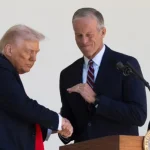
Investing is often all about capitalizing on and getting in early on revolutionary and secular trends that are going to shape the economy going forward for decades. In an attempt to try and determine what the future holds in that regard, this week Bloomberg asked several prominent members of the financial world what markets would look like in the year 2052, thirty years from now.
The CEO and President of NASDAQ, Adena Friedman, focused on cloud infrastructure and digitization of assets, telling Bloomberg: "The next 30 years I think are going to be really focused on value-added intermediation in the markets. The technology will exist to allow for every asset on the planet to be digitized and available to be bought and sold in an instantaneous way."
"So what are the technologies that underpin that? I think moving markets into a cloud infrastructure is going to be a critical component. Bringing more machine learning into market decisions, into crime management, into managing markets for fairness. And then I definitely think that the digital-asset ecosystem will mature very materially, to become mainstream," she continued.
Among her "digitization" predictions was a call for a central bank digital currency:
"If the blockchain can scale a lot more than it can today, I think you would see regulators get more comfortable bringing the digital- asset construct into traditional markets. You could see potential for a central bank digital currency really forming the basis for a much more digital payment structure. And then you could see capital markets opening up into a much more globalized format."
Goldman Sachs CEO David Solomon focused more on AI, green energy and biotech.
"There’s a lot of capital going into artificial intelligence already," he told Bloomberg. "With respect to medtech and biotech, we had a pandemic, and the government intervened. But generally speaking, for regular technological advancement and innovation, I don’t think we need to have public-private partnerships in the medtech or biotech space. But to drive innovative climate technologies and a faster transition to clean energy will require a much greater amount of capital than those other areas."
But he also seemed to agree with Freidman's assertion about digitization of assets:
"Most businesses are dealing with accelerating trends of digitization around their business—and automation. I happen to think that blockchain technology is an early version of technologies that will ultimately be used to further digitize the infrastructure of financial services. Because while there are a lot of good things with blockchain, it’s not a great technology for a large number of transactions at a very high speed."
CEO of Citigroup, Jane Fraser, says we are moving toward a "boundless virtual economy" - as if printing $9 trillion in 24 months was virtual enough for you already. She also harped on the digitization of assets, telling Bloomberg:
"Digital assets will be widely embraced and securitized and we will see asset “avatars” that exist in more than one form between traditional assets, digital native assets, and tokenized versions of traditional assets. In this world, market participants will be able to respond to “after hours” announcements and overseas events at any time of day and across time zones. The 24/7 nature of these transactions will reduce operational risk, streamline payments across platforms globally, and enhance the consumer and client experience."
She concluded: "One thing is certain, 2050 will be virtual and it will be boundless."
David Siegel of Two Sigma Investments LLC harped on mRNA technology, crypto and AI, while Nir Bar Dea, Co-CEO of Bridgewater Associates, said the most important innovations yet to come will allow humans to collaborate on problems together:
"The most important innovations of the next few decades will be the evolution of a suite of technologies to successfully support an “open collaboration” approach. By “open collaboration” I mean the dynamic where the best thinking is made transparent to people all over the world, so that others can digest it, learn from it, improve on it, and—ultimately, if truth and merit win out—trust it."
You can read the full comments from all Wall Street figureheads in Bloomberg's report here.
Investing is often all about capitalizing on and getting in early on revolutionary and secular trends that are going to shape the economy going forward for decades. In an attempt to try and determine what the future holds in that regard, this week Bloomberg asked several prominent members of the financial world what markets would look like in the year 2052, thirty years from now.
The CEO and President of NASDAQ, Adena Friedman, focused on cloud infrastructure and digitization of assets, telling Bloomberg: “The next 30 years I think are going to be really focused on value-added intermediation in the markets. The technology will exist to allow for every asset on the planet to be digitized and available to be bought and sold in an instantaneous way.”
“So what are the technologies that underpin that? I think moving markets into a cloud infrastructure is going to be a critical component. Bringing more machine learning into market decisions, into crime management, into managing markets for fairness. And then I definitely think that the digital-asset ecosystem will mature very materially, to become mainstream,” she continued.
Among her “digitization” predictions was a call for a central bank digital currency:
“If the blockchain can scale a lot more than it can today, I think you would see regulators get more comfortable bringing the digital- asset construct into traditional markets. You could see potential for a central bank digital currency really forming the basis for a much more digital payment structure. And then you could see capital markets opening up into a much more globalized format.”
Goldman Sachs CEO David Solomon focused more on AI, green energy and biotech.
“There’s a lot of capital going into artificial intelligence already,” he told Bloomberg. “With respect to medtech and biotech, we had a pandemic, and the government intervened. But generally speaking, for regular technological advancement and innovation, I don’t think we need to have public-private partnerships in the medtech or biotech space. But to drive innovative climate technologies and a faster transition to clean energy will require a much greater amount of capital than those other areas.”
But he also seemed to agree with Freidman’s assertion about digitization of assets:
“Most businesses are dealing with accelerating trends of digitization around their business—and automation. I happen to think that blockchain technology is an early version of technologies that will ultimately be used to further digitize the infrastructure of financial services. Because while there are a lot of good things with blockchain, it’s not a great technology for a large number of transactions at a very high speed.”
CEO of Citigroup, Jane Fraser, says we are moving toward a “boundless virtual economy” – as if printing $9 trillion in 24 months was virtual enough for you already. She also harped on the digitization of assets, telling Bloomberg:
“Digital assets will be widely embraced and securitized and we will see asset “avatars” that exist in more than one form between traditional assets, digital native assets, and tokenized versions of traditional assets. In this world, market participants will be able to respond to “after hours” announcements and overseas events at any time of day and across time zones. The 24/7 nature of these transactions will reduce operational risk, streamline payments across platforms globally, and enhance the consumer and client experience.”
She concluded: “One thing is certain, 2050 will be virtual and it will be boundless.”
David Siegel of Two Sigma Investments LLC harped on mRNA technology, crypto and AI, while Nir Bar Dea, Co-CEO of Bridgewater Associates, said the most important innovations yet to come will allow humans to collaborate on problems together:
“The most important innovations of the next few decades will be the evolution of a suite of technologies to successfully support an “open collaboration” approach. By “open collaboration” I mean the dynamic where the best thinking is made transparent to people all over the world, so that others can digest it, learn from it, improve on it, and—ultimately, if truth and merit win out—trust it.”
You can read the full comments from all Wall Street figureheads in Bloomberg’s report here.






